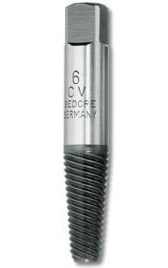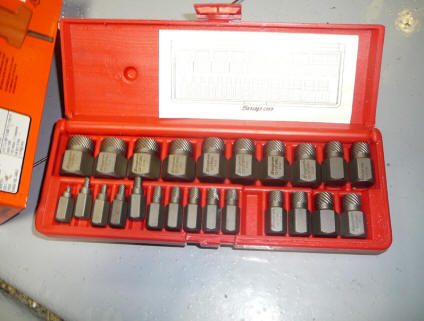


Read this: kukko bolt extractors.pdf



| Gedore | 8551-1 | 8551-2 | 8551 3 | 8551 4 | 8551 5 | 8551 6 | 8551 7 | 8551 8 |
| M 3 - M 6 | M 6 - M 8 | M 8 - M 11 | M 11 - M 14 | M 14 - M 18 | M 18 - M 24 | M 24 - M 33 | M 33 - M 45 | |
| Wrench size (mm) | 2,7 | 2,8 | 4,9 | 7,0 | 9,0 | 12,0 | 14,5 | 18,0 |
| Length (mm) | 50 | 57 | 65 | 70 | 80 | 85 | 95 | 100 |
| Weight (g) | 4 | 9 | 13 | 30 | 50 | 100 | 150 | 290 |
| Drill (mm) | 1,8 | 2,6 | 3,7 | 5,5 | 7,0 | 10,3 | 13,7 | 18,6 |
| Part number | 8551-1 | 8551-2 | 8551 3 | 8551 4 | 8551 5 | 8551 6 | 8551 7 | 8551 8 |
| EAN mumber | 4010886675847 | 4010886675854 | 4010886675861 | 4010886675878 | 4010886675885 | 4010886675908 | 4010886675915 | 4010886675939 |
| Code number | 6758490 | 6758570 | 6758650 | 6758730 | 6758810 | 6759030 | 6759110 | 6759380 |
| Screw outside diam AF | 1/8-1/4 | 1/4-5/16 | 5/16-7/16 | 7/16-9/16 | 9/16-3/4 | 3/4-1 | 1-1.3/8 | 1.3/8-1.3/4 |
| Screw outside diam mm | M 3 - M 6 | M 6 - M 8 | M 8 - M 11 | M 11 - M 14 | M 14 - M 18 | M 18 - M 24 | M 24 - M 33 | M 33 - M 45 |
=======================
Hey Jay:
I saw this old post, I just broke the bottom H20 pump bolt (!), should I be concerned about the depth of the thread for that bolt. How deep can I drill?
Your solution of drill and tap with next size bolt is a good one.
Thanks
Dave Petry 1984 Euro 928S
==========
You can drill to the depth of the original hole without any trouble. Get a drill bit that fits the nearest good hole and mark this depth with masking tape or a collar. Then transfer that to the correct size drill bit and make your new pilot hole. You have to be REAL careful not to stray off of the existing bolt. Use a dremel to make a nice flat spot and then make a sharp center punch on the flat. Then start with really small bits and work up. If you do that right you might even get the bolt out before making a mess. Brad Orr (wonder what happened to him lately) suggested doing these steps with a series of left handed drill bits and the act of doing it might just kick the slug out. I had made a big mess before that suggestion so that wasn't an option for me.
Good Luck!!!!! Drill straight in!!!!!!
Jay Kempf
================
At 03:15 PM 11/11/01 -0500, Jay wrote:
> Brad Orr (wonder what happened to him lately) suggested doing these steps with a series of left handed drill bits and the act of doing it might just kick the slug out.
Indeed I did. Left hand bits are THE answer for this problem. If done
properly, they offer the absolute highest potential of removing the
broken fastener and leaving the original female threads intact. I have
had to do this literally hundreds of times over too many years.
Dave, if you haven't attempted surgery yet and want more specifics
let me know.
Brad Orr
==============
Nick,
Just take the undoing of the bolts really easy and slow. If there is any
feeling of unusual tightness, try undo a little, then tighten a little, back
and forth, gently, slowly, no rush....
This will frequently get a corroded bolt out with minimum risk of breakage.
Maybe a tap inwards on the head with a small hammer will also help to break
the grip of the corrosion - just a few light taps, some penetrating spray
wont hurt either.
I had one of my water pump bolts break off, leaving about 3/8" sticking out of the block. A few sprays of WD40, tap with a hammer, do something else, tap again, grab with vise grips, and out it came.
Before fitting new pump, clean all the threads with a plug tap, also
CAREFULLY, slowly, with lubrication - you don't want to break a tap off in
there, they are HARD!
Good luck,
jp
83 S
============
The key to centering on a bolt is using a small pilot drill first -
much less than an 1/8 inch. The hole in the pump is much too large to
allow for centering such a small drill. A bushing made of harder metal
inserted into the water pump bolt hole should be accurate enough to
center the drill. The guide if long enough would also guarantee the
correct angle. The guide could also be used for a center punch to
start the pilot drill. The trick in drilling out any broken bolt is getting the
pilot hole centered.
You were lucky to get the bolt out that was broken. Often the threads
fuse and the resistance is more than the strength of the bolt itself.
In these cases an easy out is useless and the only chance is drilling the thing
out.
A three drill regimen is probably the best. A very small drill for a
pilot, a bigger drill to accommodate an easy out and the third drill
the size required by a tap. Re-tapping the hole is not a perfect
solution but probably good enough for most cases. Only one bushing
should be needed as once the pilot is straight the rest of the drills
should track, but additional bushing would only improve the job.
Finally, I find a 90 degree offset air drill the easiest to use in
these cases. It is small, light, fast and can be adjusted for speed by
varying air pressure.
Dan the Pod Guy
Portia's Parts
============
An improvement is to use a left-hand drill bit for the second and third
tries. It is surprising how often the broken bolt will back itself out.
Harbor Freight strikes again!
Wally Plumley
928 Specialists
At 01:15 AM 3/11/2005, Dan Brindle wrote:
>I have heard of left handed monkey wrenches but not drills.
Not common, but available - Harbor Freight has a set.
http://www.harborfreight.com/cpi/ctaf/Displayitem.taf?itemnumber=38180
============
Tom,
You are only partially correct on the use of cold to loosen the bolts - indeed,
the aluminum has a higher contraction coefficient than steel, and the aluminum
will shrink more than the steel. When that happens, however, the bolt hole gets
LARGER, not smaller - which is why they come out relatively easily.
Doug
89GT